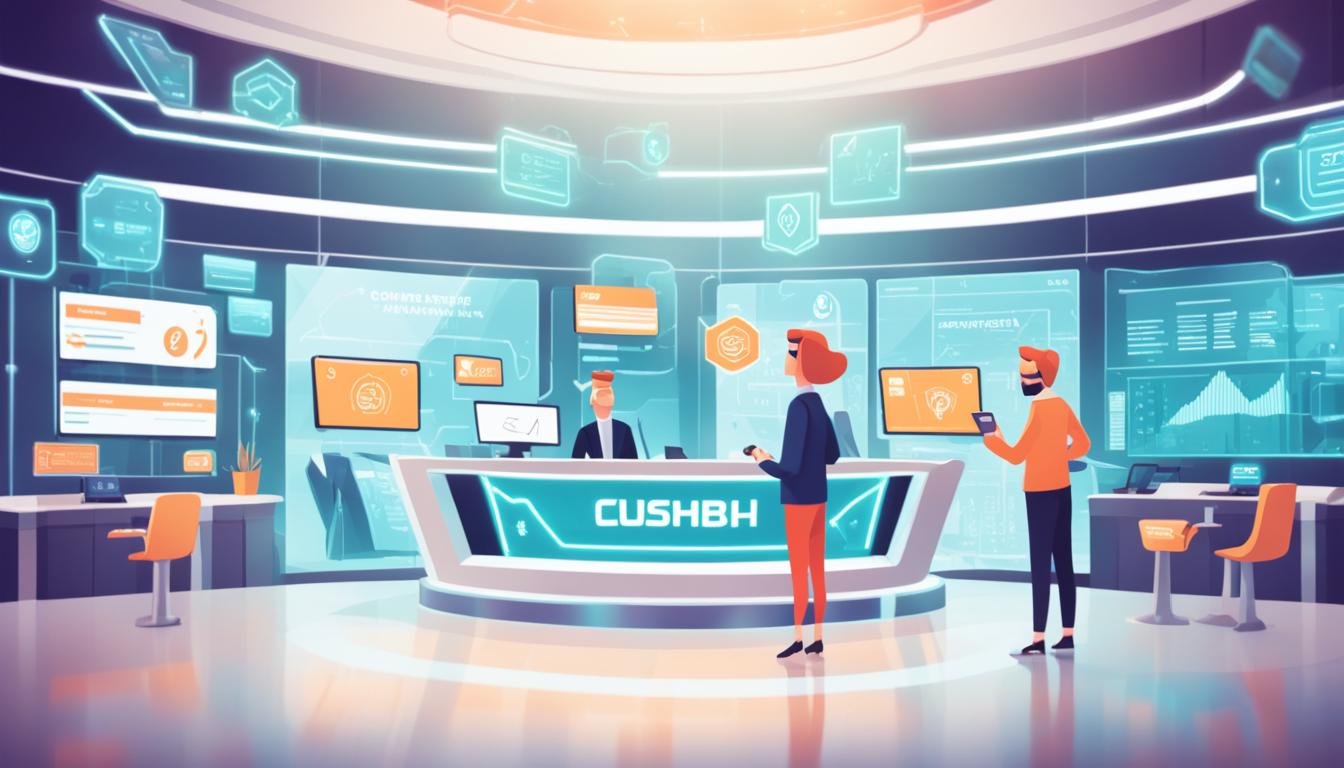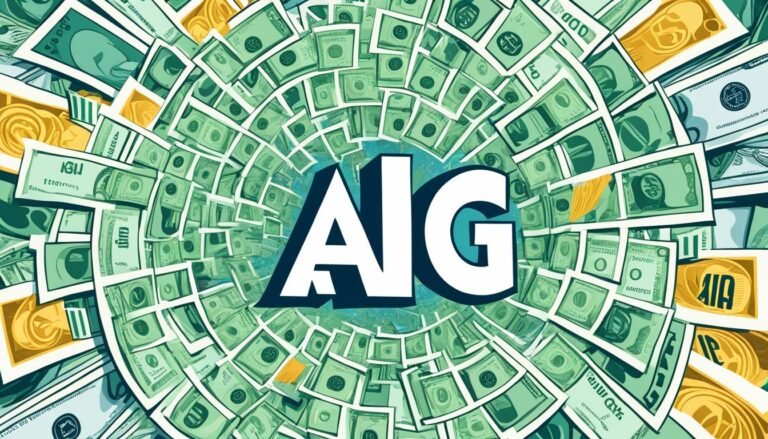The Intersection of Gaming and Finance: Gamification in Banking
Did you know that gamification is projected to grow into a $30.7 billion market by 2025? This innovative trend in the finance and gaming industries is revolutionizing the way we engage with money and entertainment. Gamification, the process of adding game-like elements to non-game contexts, has the power to increase engagement, motivation, and loyalty in the financial industry.
As the integration of gaming and finance expands, it goes beyond gamification and extends to other areas such as blockchain technology. This convergence presents new opportunities for innovation and growth, but also comes with risks and challenges.
Key Takeaways:
- Gamification is projected to be a $30.7 billion market by 2025.
- Gamification increases engagement, motivation, and loyalty in the financial industry.
- The integration of gaming and finance extends beyond gamification to include blockchain technology.
- The future of gaming and finance presents opportunities for innovation and growth, but also comes with risks and challenges.
- Responsible and ethical use of gamification and gaming technology is important for regulators, businesses, and consumers in the financial industry.
The Rise of Gamification in Fintech and Gaming
Gamification has revolutionized both the fintech and gaming industries by introducing game-like elements to non-game contexts, such as financial services. It has gained significant popularity in recent years, thanks to its ability to enhance engagement, motivation, and loyalty among users. In the financial industry, gamification has been effectively used to educate customers about complex financial concepts, encourage saving and investing, and reward positive financial behavior.
The market for gamification is projected to experience remarkable growth, with estimates indicating a rise from $9.1 billion in 2020 to a staggering $30.7 billion by 2025. This growth will be driven by factors such as the widespread use of mobile devices, the influence of social media, and the advancement of the Internet of Things (IoT). These developments create vast opportunities for startups as well as established companies to leverage gamification’s transformative potential.
Financial institutions are increasingly integrating gamification techniques, allowing customers to engage with money and entertainment in innovative ways. By making financial processes interactive and enjoyable, gamification has the power to revolutionize the traditional norms surrounding finance.
Gamification in Fintech
Within the fintech sector, gamification has proven extremely beneficial by providing users with a more immersive and interactive banking experience. Traditional finance can often be perceived as complex and intimidating, causing disengagement and apathy among consumers. However, by incorporating game-like elements, fintech platforms can simplify financial concepts, making them more accessible and enjoyable.
Gamification also acts as a driving force behind positive financial habits. By offering challenges, rewards, and incentives, fintech apps motivate users to save, invest, and achieve their financial goals. These gamified financial services can transform mundane tasks such as budgeting and expense tracking into interactive experiences, fostering a sense of accomplishment and progress.
Gamification in Gaming
The gaming industry has also witnessed the rise of gamification as a powerful tool. Game developers have integrated gamified features and mechanics into their games, enhancing engagement and increasing player satisfaction. These features can include progress tracking, achievement badges, leaderboards, and various interactive challenges.
Furthermore, the introduction of non-fungible tokens (NFTs) in gaming has taken the concept of gamification to a whole new level. NFTs allow players to own and trade unique in-game assets, providing them with tangible value and creating a thriving virtual economy. Games like “CryptoKitties” and “Axie Infinity” have pioneered this trend, showcasing new possibilities for gamers and developers.
| Benefits of Gamification in Fintech and Gaming | Gaming Industry | Fintech Industry |
|---|---|---|
| Enhanced engagement and motivation | ||
| Increased user loyalty and retention | ||
| Education on complex financial concepts | ||
| Encouragement of positive financial behavior |
Gamification in both the fintech and gaming industries offers numerous benefits, ranging from enhanced engagement and motivation to increased user loyalty and retention. By leveraging game-like elements, these industries can educate users on complex financial concepts, encourage positive financial habits, and create more immersive and interactive experiences.
Gamification in Banking: Benefits and Strategies
Gamification in banking is revolutionizing the customer experience and driving positive financial behavior. By incorporating game-like elements, banks can educate customers about complex financial concepts in a way that is fun, engaging, and easy to understand. This approach not only improves financial literacy but also encourages customers to save and invest.
One of the popular gamification strategies in banking is setting up savings challenges. Through gamified interfaces, customers can set specific saving goals and track their progress in a visually appealing manner. This feature helps customers develop disciplined saving habits and achieve their financial milestones.
Investment simulations and virtual stock trading games are another effective gamification strategy in banking. These tools allow customers to learn and practice investment strategies in a risk-free environment. By gaining hands-on experience, customers can build confidence and make informed investment decisions.
Rewards and incentives play a crucial role in motivating customers to achieve their financial goals. By offering virtual badges, points, or even tangible rewards, banks can incentivize customers to engage with their financial products and services. This gamification strategy enhances customer loyalty and fosters a sense of accomplishment.
There are already successful examples of gamification in banking. Acorns, an investment app, rounds up customers’ purchases to the nearest dollar and invests the spare change. This simple and gamified approach makes investing accessible to everyone, regardless of their financial knowledge. Similarly, Robinhood, a commission-free trading app, rewards customers for referring friends to their platform. This gamification strategy encourages customer acquisition through social interaction.
However, gamification in banking comes with risks that need to be addressed. One concern is the potential encouragement of risky behavior. Banks must ensure that their gamified features promote responsible financial decision-making and don’t incentivize customers to take unnecessary risks.
Similarly, the gamification of complex financial concepts should strike a balance between simplicity and accuracy. Oversimplifying important financial terms and concepts can lead to misunderstandings and misguided financial decisions. Banks must focus on providing accurate information while making it engaging and accessible.
To ensure the responsible and ethical use of gamification in the financial industry, regulators, businesses, and consumers need to collaborate. Clear guidelines and best practices should be established to protect customers and maintain industry standards.
“Gamification in banking offers exciting benefits for both customers and banks. By leveraging gamified strategies, banks can educate, motivate, and reward customers, leading to enhanced financial well-being and long-term loyalty.”
Benefits of Gamification in Banking:
- Enhances customer experience through interactive and engaging features
- Increases financial literacy by simplifying complex financial concepts
- Encourages saving and investing through goal-setting and progress tracking
- Improves customer loyalty and satisfaction through rewards and incentives
- Fosters responsible financial decision-making and risk management
Gamification Strategies in Banking:
- Savings challenges
- Investment simulations and virtual stock trading games
- Rewards and incentives
By implementing gamification strategies and ensuring their responsible use, banks can harness the power of gamification to create a more engaging and rewarding banking experience for their customers.
| Benefits of Gamification in Banking | Gamification Strategies |
|---|---|
| Enhances customer experience | Savings challenges |
| Increases financial literacy | Investment simulations and virtual stock trading games |
| Encourages saving and investing | Rewards and incentives |
| Improves customer loyalty and satisfaction | |
| Fosters responsible financial decision-making |
The Impact of Gaming in Finance
The impact of gaming in finance extends beyond the realm of gamification. With the rise of digital platforms and mobile gaming, gaming has reached new levels of accessibility and popularity. This convergence of gaming and finance has created a unique synergy between the two industries, leading to the emergence of innovative startups and established companies that leverage their similarities in technology, data, and customer experience.
Gaming and finance industries face common challenges when it comes to cybersecurity and data privacy. Both sectors are heavily regulated and must navigate the evolving landscape of digital threats. However, they also share common opportunities for growth and advancement.
One of the transformative technologies that underpins both gaming and finance is blockchain. Blockchain technology, known for its role in cryptocurrencies like Bitcoin and Ethereum, offers solutions to key challenges in both industries. It enhances transparency, reduces fraud, and creates more secure and efficient payment systems. The integration of blockchain technology has the potential to revolutionize the way we engage with money and entertainment.
Through this intersection, gaming and finance are reshaping and redefining customer engagement and experiences. The impact of gaming in finance can be witnessed through various applications, such as digital payment platforms, virtual currencies, and immersive financial simulations.
Moreover, the convergence of gaming and finance presents new opportunities for startups and established companies to merge their expertise. This collaboration allows them to leverage the strengths of both industries and create innovative products and services that cater to the evolving demands of consumers.
In summary, the impact of gaming in finance goes beyond gamification, encompassing a range of technologies and strategies that drive innovation and transformation. The integration of gaming and finance not only enhances the customer experience but also presents challenges and opportunities that shape the future of both industries.
The Power of Gamification in Employee Engagement and Learning
Gamification is a powerful tool that goes beyond the financial industry and offers significant benefits in employee engagement and learning. Numerous studies have shown that incorporating gamification into work experiences can boost employee productivity and satisfaction. By introducing game-like elements, learning becomes more engaging, leading to higher retention rates and increased productivity among workers.
Gamification helps employees stay focused on their tasks, avoid distractions, and retain important skills. It offers a fun and practical problem-solving environment that provides opportunities for skill refinement and instant feedback. This interactive approach to learning not only enhances their knowledge but also improves their overall performance.
Companies can use gamification to incentivize employees and drive positive behavior. By integrating gamified rewards into performance measures, such as completing tasks or achieving targets, organizations can motivate their employees to excel. This can lead to improved customer satisfaction, increased employee loyalty, and enhanced overall performance.
One successful example of gamification in employee engagement is LiveOps, a customer service agency. They implemented a rewards program that recognized and rewarded outstanding performance, resulting in significant improvements in both employee satisfaction and performance.
“Gamification provides a platform for employees to truly engage and utilize their skills in a way that feels natural and enjoyable. It enhances the learning experience by promoting active participation and instant feedback, ultimately driving employee productivity and satisfaction,” says Michael Johnson, HR Manager of LiveOps.”
Benefits of Gamification in Employee Engagement and Learning:
- Increased employee productivity: Gamification improves focus, attention, and task completion, resulting in higher productivity levels.
- Enhanced employee satisfaction: The interactive and fun nature of gamification boosts employees’ morale and satisfaction with their work.
- Improved learning outcomes: Gamified learning experiences help employees retain knowledge, develop skills, and apply them effectively in their roles.
- Opportunities for skill refinement: Gamification provides employees with a safe environment to practice and refine their skills, allowing for continuous improvement.
- Instant feedback: Employees receive immediate feedback on their performance, enabling them to identify areas for improvement and make necessary adjustments.
Gamification in employee engagement and learning has been linked to better outcomes in skill-based assessments and factual knowledge tests. It offers a dynamic and stimulating approach to training and development, leading to more efficient and effective learning experiences for employees.
| Benefit | Explanation |
|---|---|
| Increased employee productivity | Gamification improves focus, attention, and task completion, resulting in higher productivity levels. |
| Enhanced employee satisfaction | The interactive and fun nature of gamification boosts employees’ morale and satisfaction with their work. |
| Improved learning outcomes | Gamified learning experiences help employees retain knowledge, develop skills, and apply them effectively in their roles. |
| Opportunities for skill refinement | Gamification provides employees with a safe environment to practice and refine their skills, allowing for continuous improvement. |
| Instant feedback | Employees receive immediate feedback on their performance, enabling them to identify areas for improvement and make necessary adjustments. |
Integrating gamification into employee engagement and learning programs can have a profound impact on an organization’s success. It not only improves employee performance but also fosters a positive and engaging work culture. By leveraging the power of gamification, companies can unlock the full potential of their workforce and create a more productive and satisfied team.
The Potential of NFTs and Gaming
Non-fungible tokens (NFTs) have emerged as a significant force in the gaming industry, going beyond their initial association with overpriced digital images. NFTs are unique cryptographic assets on a blockchain, distinguished by their distinct identification data, setting them apart from other tokens. These tokens carry immense potential and can be utilized for various purposes, including financial transactions, verification of authenticity in goods and identity, and even serving as event tickets.
For gamers, NFTs have opened up a whole new realm of possibilities, enabling them to earn and trade virtual assets as rewards. This means that players can now truly own their in-game items, investing time and effort into building valuable collections. Games like “CryptoKitties” and “Axie Infinity” have exemplified the potential of blockchain-based gaming experiences that integrate NFTs, revolutionizing the way gamers interact and engage with virtual worlds.
The incorporation of NFTs into gaming is expanding the intersection of gaming and finance, creating exciting new opportunities for gamers and developers alike. By introducing true digital ownership and an open market for virtual assets, NFTs empower gamers to monetize their skills and efforts, fostering a more immersive and rewarding gaming ecosystem.
Key Takeaways:
- NFTs are unique cryptographic assets that have gained attention in the gaming industry.
- These tokens can be used for financial transactions, verifying authenticity, and even serving as event tickets.
- Gamers can now earn and trade virtual assets as rewards, truly owning their in-game items.
- Blockchain-based games like “CryptoKitties” and “Axie Infinity” demonstrate the potential of NFT integration.
- NFTs expand the intersection of gaming and finance, offering new opportunities for gamers and developers.
Incorporating Gamification in Financial Services
Gamification has become a popular strategy in the financial services industry to enhance customer engagement and drive positive financial behavior. By incorporating game-like elements into financial services, gamification offers a range of benefits that can revolutionize the customer experience.
Increased User Engagement: Gamification increases user engagement by making financial tasks more interactive and enjoyable. By turning financial activities into fun challenges and games, customers are more likely to stay actively involved and motivated.
Improved User Retention: Gamification strategies help improve user retention rates by creating a sense of loyalty. When customers find financial services entertaining and rewarding, they are more likely to stick with the platform for their financial needs.
Enhanced User Experience: Incorporating gamification into financial services transforms the user experience, making it more interactive, intuitive, and enjoyable. Gamification elements such as progress bars, badges, and leaderboards make financial tasks feel like a game, enhancing the overall experience.
Increased User Loyalty: Gamification fosters a sense of competitiveness among users, motivating them to achieve their financial goals and earn rewards. By creating achievements, milestones, and incentives, financial services can cultivate a loyal customer base who actively participate in the platform.
To illustrate the impact of gamification in financial services, consider the following examples:
Acorns: Acorns is an investment app that incorporates gamification elements to encourage users to save and invest. The app rounds up purchases to the nearest dollar and invests the spare change. Users can track their progress, set goals, and earn rewards for reaching milestones.
Robinhood: Robinhood is a commission-free trading app that uses gamification to attract and engage users. The app offers rewards for referring friends, creating a sense of competition and motivation among users.
Gamification in financial services has the potential to transform the way customers interact with their finances, making it more interactive, engaging, and enjoyable. By incorporating elements of gameplay, financial institutions can create a more immersive experience that encourages positive financial behavior and fosters long-term customer loyalty.
The Future of Gaming and Finance
The future of gaming and finance is heading towards a fascinating convergence. As gamification, blockchain technology, and other innovative technologies continue to rise, they create new opportunities for growth and innovation in both industries. With the increasing trust, transparency, safety, and usability of cryptocurrencies and digital assets, their mass adoption is becoming more imminent.
Gaming and finance are on a path of continued evolution as blockchain technology and cryptocurrencies gain wider acceptance. These advancements are reshaping the gaming industry and presenting new avenues for financial opportunities. Technology trends like Non-Fungible Tokens (NFTs) and the surging popularity of esports are transforming traditional gaming and opening up a whole new world of financial possibilities.
The Potential Impact of Cryptocurrency Adoption
Cryptocurrency adoption has experienced significant growth in recent years, with the global crypto market projected to reach $184.0 billion in 2023. However, the percentage of Americans owning cryptocurrencies is still below 10%. This indicates a vast potential for growth and adoption in the future.
The adoption of digital assets offers numerous benefits for individuals and businesses. One of the key advantages is the greater control over investments, allowing investors to manage their portfolios independently without relying on intermediaries. Additionally, cryptocurrencies provide access to a broader range of investment opportunities, including decentralized finance (DeFi) protocols, which offer innovative and potentially lucrative financial services.
Moreover, cryptocurrency adoption can be cost-effective, enabling cost savings in various financial transactions such as cross-border payments. Traditional payment methods often involve high fees and lengthy processing times, making them inefficient for global transactions. On the other hand, cryptocurrencies facilitate fast and low-cost transactions, enabling seamless international transfers.
The future outlook for cryptocurrency adoption is promising, driven by increased trust, transparency, safety, and usability. As technology continues to advance, cryptocurrencies are becoming more user-friendly and secure. Digital payments and cryptocurrency acceptance are becoming more widespread, further fueling the adoption of digital assets.
Just as the internet revolutionized the way we communicate and access information, the gradual adoption of cryptocurrencies is expected to skyrocket in the coming years. As the benefits of cryptocurrencies become more widely recognized, more individuals and businesses will embrace this new financial paradigm.
The Benefits of Cryptocurrency Adoption:
- Greater control over investments
- Access to a broader range of investment opportunities
- Cost-effectiveness in financial transactions
- Increased trust, transparency, safety, and usability
Cryptocurrency adoption presents a remarkable opportunity for individuals and businesses to participate in the future of finance. By staying informed and embracing this new digital frontier, individuals and organizations can benefit from the potential growth and innovation that cryptocurrencies offer.
Conclusion
The intersection of gaming and finance presents exciting opportunities for innovation and growth. The incorporation of gamification in banking and financial services has the potential to enhance the customer experience and drive positive financial behavior. By integrating game-like elements and rewards into financial activities, gamification can educate customers, encourage savings and investments, and motivate them to achieve their financial goals.
The rise of non-fungible tokens (NFTs) and blockchain technology in gaming opens up new possibilities for gamers, allowing them to earn and trade virtual assets as rewards. NFTs have the potential to revolutionize the way gamers interact with digital assets, creating a more immersive and rewarding gaming experience.
In addition to enhancing customer engagement and gaming experiences, gamification also has a significant impact on employee engagement and learning. By incorporating game-like elements into work experiences, businesses can boost employee productivity, satisfaction, and skills development. Gamification creates a fun and practical problem-solving environment, allowing employees to stay focused, avoid distractions, and improve their performance.
The future of gaming and finance is intertwined, with the mass adoption of cryptocurrencies and digital assets on the horizon. As technology continues to advance and digital payments become more widely accepted, the convergence of gaming and finance will continue to evolve. While there are risks and challenges associated with gamification and cryptocurrency adoption, responsible and ethical use can lead to a harmonious blend of fun and profit. Embracing the fusion of finance and gaming opens up a world of possibilities for individuals, businesses, and industries as a whole.
FAQ
What is gamification in banking?
How is gamification used in banking?
What are the benefits of gamification in banking?
What are the risks associated with gamification in banking?
How does gaming impact the finance industry?
What is the potential of gamification in employee engagement and learning?
How do non-fungible tokens (NFTs) impact gaming?
How is gamification incorporated into financial services beyond banking?
What does the future hold for the intersection of gaming and finance?
What is the potential impact of cryptocurrency adoption in finance?
What is the conclusion of the intersection of gaming and finance?
Source Links
- https://www.albanybeck.com/news-and-insights/the-future-of-finance-and-fun-how-fintech-and-gaming-are-shaping-the-future-of-industries
- https://www.linkedin.com/pulse/finance-economics-gaming-industry-perfect-marriage-fun-xanthos-n7wzf
- https://fintechly.com/cryptocurrencies/dispelling-digital-currency-myths-gamification-in-finance/








